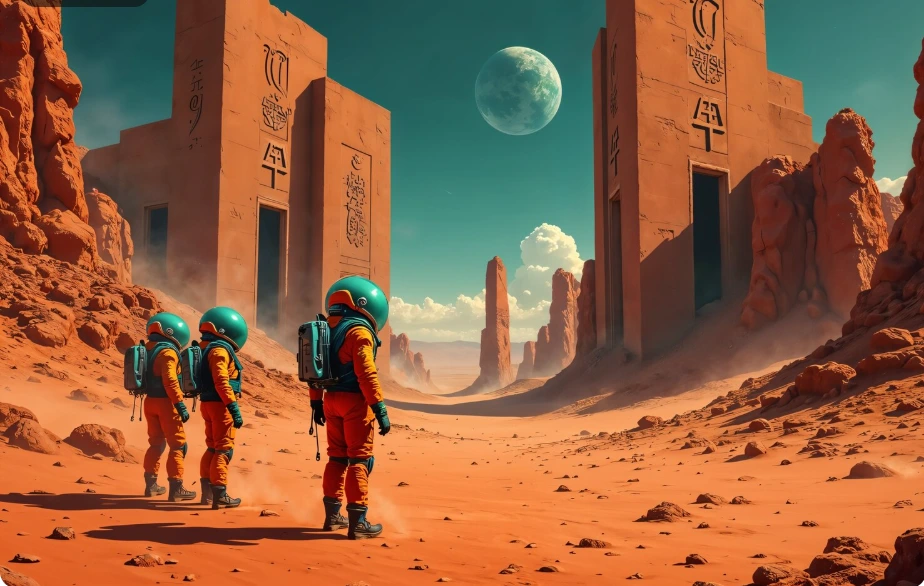Introduction
Interplanetary Travel refers to the journey of spacecraft (crew‑ed or uncrewed) between planets within a single solar system. It involves leaving Earth, overcoming gravitational forces, traversing space, and finally reaching another planet. With advances in rocket technology, life‑support systems, and space propulsion, interplanetary travel is no longer just science fiction—it’s becoming an achievable goal. This article explores what interplanetary travel is, its history, the challenges, current progress, future technologies, and what it would mean for humanity.
1. What is Interplanetary Travel?
- Interplanetary Travel includes both robotic missions (probes, rovers, orbiters) and human missions.
- It differs from interstellar travel, which is travel between stars. Interplanetary travel stays within one star system, such as the Solar System.
- Key components include launch, escaping Earth gravity, navigating space, performing trajectory corrections, entering orbit or landing, and ensuring safe return (for crewed missions).
2. A Brief History
- Early robotic missions: flybys, orbiters, and landers to Mars, Venus, Mercury, the outer planets, moons, comets, and asteroids.
- Manned missions so far have been limited to the Moon (which is sub‑planetary travel in solar system context). Human interplanetary missions (beyond the Moon) are planned but not yet realised.
3. Importance & Motivations for Interplanetary Travel
- Scientific Discovery: studying environments on Mars, Venus, moons like Europa, Titan, etc., help in understanding planetary formation, geology, atmospheres, potential for life.
- Resource Utilization: minerals, water ice on other planets or moons or asteroids could be useful.
- Human Survival & Expansion: as Earth faces resource limitations, climate change, the idea of expanding human presence becomes more pressing.
- Inspiration & Technology Spin‑Offs: technologies developed for interplanetary missions often lead to advances in materials, robotics, life‑support, energy systems.
4. Key Technical Aspects
4.1 Propulsion & Trajectory Planning
- Chemical rockets are currently standard for leaving Earth orbit and initial acceleration. But for long interplanetary transfer, they are inefficient.
- Alternative propulsion systems under research: ion engines, nuclear thermal propulsion, fusion propulsion, solar sails, light sails powered by laser arrays
- Trajectory planning often uses gravity assists (“slingshot effect”) to gain speed and reduce fuel requirements.
4.2 Life Support & Closed‑Loop Systems
- For crewed interplanetary travel, ensuring sustainable life support is crucial. This includes recycling air, water, food, managing waste, maintaining hygiene.
- Protection from cosmic radiation and solar radiation is vital. Space outside Earth’s magnetosphere is hazardous. Shielding, advance materials and possibly active radiation protection are needed.
4.3 Human Health, Psychology & Duration
- Microgravity effects: muscle atrophy, bone loss, cardiovascular deconditioning, fluid shifts. Countermeasures include exercise, possibly artificial gravity.
- Psychological stress: isolation, confinement, limited interaction with Earth, monotony, delayed communication. These challenge crew well‑being.
- Duration: a trip to Mars might take months; to more distant destinations, years. Longer durations increase risk.
5. Major Challenges of Interplanetary Travel
Here are some of the most significant obstacles:
| Challenge | Explanation |
|---|---|
| Launch & Escape Velocity | Overcoming Earth’s gravity well requires huge energy. Once in space, achieving velocity to leave Earth orbit and move toward target planet demands more propellant or high‑efficiency propulsion. |
| Fuel and Mass Constraints | Fuel is heavy; increasing fuel increases mass, which increases fuel required, etc. Payload mass versus fuel mass is a critical design trade‑off. |
| Radiation Exposure | Outside Earth’s magnetic field (magnetosphere), cosmic rays, solar energetic particles pose serious hazard to electronics and humans. Long‑term exposure can increase cancer risk, damage organs. |
| Microgravity Effects | Prolonged weightlessness causes muscle & bone weakening, fluid distribution changes, vision issues. |
| Life Support Reliability | Systems must run for long durations without resupply. Failure or unexpected issues (equipment, microbial contamination, system breakdown) can be catastrophic. |
| Communication Delays | As distance increases, signals take more time (for example, Earth‑Mars one‑way can be between ~4 to ~22 minutes depending on positions). Real‑time control becomes impossible; autonomy is required. |
| Trajectory & Navigation Complexity | Planet positions change; gravitational interactions; requiring precise burns, course corrections. Launch windows only open at certain times. |
| Energy & Power Supply | Solar power drops off with distance from the Sun; alternative power sources (nuclear) may be required. Energy storage, generation and reliability become critical. |
| Cost & Funding | Long timelines, expensive R&D, infrastructure, political & financial risks over decades. Funding continuity is a huge challenge. |
6. Current Efforts & Progress
- Recent robotic explorations: missions to Mars (rovers, orbiters), Venus, outer planets, dwarf planets, comets, asteroids.
- Technologies being developed: nuclear fusion propulsion (e.g. Direct Fusion Drive) in research stage.
- Innovative proposals: laser‑driven light sails to speed up transit times (e.g. from Earth to Mars in significantly shorter time frames) are being studie
- National space agencies (NASA, ESA) and private companies (SpaceX, others) are planning or proposing human missions to Mars; development of habitats, life support, radiation shielding, etc.
7. Future Technologies & Ideas
Some of the futuristic or next‑generation ideas to enable safer, faster, more feasible interplanetary travel:
- Nuclear Thermal Propulsion & Nuclear Electric Propulsion: using nuclear reactions to heat propellant, or to generate electric power for ion drives.
- Fusion Propulsion: aneutronic fusion reactors (if realized) could provide much higher energy density and thrust.
- Light Sail / Solar Sail Concepts: using radiation pressure or laser beams to push sails, potentially enabling high speeds without carrying all the fuel.
- Artificial Gravity: rotating habitats or sections to simulate gravity, mitigating health risks of microgravity.
- Improved Radiation Shielding: advanced materials, possibly active magnetic shields, or spacecraft architecture that uses water, regolith, etc., as shielding.
- Autonomous Systems & AI: since communication delays are inevitable, more autonomy in spacecraft systems and crew decision‑making is required.
8. What a Crewed Mission to Mars Might Involve (Case Study)
To illustrate how interplanetary travel might look in practice, here is a sketch of a Mars mission:
- Preparation Phase
- Developing habitat modules, life support, radiation shielding, safe landing systems.
- Training crew, psychological preparation.
- Launch & Transit
- Launch during optimal Mars launch window.
- Use high‑efficiency propulsion, possibly assisted by gravity flybys.
- Transit time might be ~6‑9 months with current technology; future tech might reduce this.
- Mars Orbit Insertion, Descent & Landing
- Enter Mars orbit; land using aeroshells, parachutes, retro‑rockets. Soft landing is challenging due to Mars’ thin atmosphere.
- Surface Operations
- Habitat operations, scientific missions, resource extraction (e.g., water ice).
- Return Journey (if crewed return mission)
- Launch from Mars surface, rendezvous with orbiting vehicle, return transit to Earth.
- Risks & Contingencies
- System failures, medical emergencies, radiation events, resource shortages.
9. Ethical, Social & Environmental Considerations
- Planetary Protection: preventing contamination of other worlds with Earth microbes (forward contamination), and protecting Earth from potential back‑contamination.
- Psychological impact and crew welfare: Isolation, possible conflict, mental health under long durations.
- Long‑term environmental effect: space debris, the impact of launches on Earth’s atmosphere.
- Inequality and access: who gets to go, who funds, who benefits.
10. What Interplanetary Travel Means for Humanity
- Potential colonization or long‑term bases on Mars, Moon, perhaps moons of outer planets.
- A backup for civilization in case of catastrophic events on Earth.
- New industries: space mining, tourism, off‑Earth agriculture, manufacturing.
- Expansion of human perspective, philosophical, cultural growth.
11. Conclusion
Interplanetary Travel is one of the most ambitious undertakings mankind has ever contemplated. It presents formidable technical, physiological, economic, and ethical challenges. But with steady progress in propulsion, life‑support, materials, AI, and mission planning, the dream is slowly becoming reality. Whether in this century or beyond, interplanetary travel stands as a milestone that could redefine our place in the cosmos.
Frequently Asked Questions (FAQs)
Here are common questions about Interplanetary Travel, with answers.
- What is the difference between interplanetary travel and interstellar travel?
Interplanetary travel means traveling between planets within the same solar system (for example, from Earth to Mars). Interstellar travel means traveling between stars, which involves far greater distances and challenges. - How long does it take to travel to Mars?
With current technology (chemical rockets and orbital mechanics), a one‑way trip takes about 6 to 9 months, depending on the launch window and trajectory. Future propulsion technologies might reduce that significantly. - What are launch windows?
Launch windows are specific times when the positions of Earth and target planet (e.g. Mars) align in such a way that the journey uses the least amount of energy/fuel. These windows open every ~2 years for Mars. - How do spacecraft protect crew from radiation?
Radiation protection includes shielding with material (e.g. regolith, specialized metals, water), using spacecraft design to minimize exposure, possibly active magnetic shielding, monitoring solar activity, and planning missions to avoid solar storms. - What happens to human bodies during long space travel?
Effects include loss of bone density and muscle mass, fluid shifts, weakening of the cardiovascular system, possibly vision changes, and psychological issues. Countermeasures include exercise, artificial gravity or partial gravity, careful diet, mental health support. - Why is communication delay a problem?
Because signals travel at the speed of light, there is always a delay (for example, up to ~20 minutes one way between Earth and Mars). That means no real‑time control or conversation; systems and crews need autonomy. - What propulsion methods are being developed for faster travel?
Several promising methods: nuclear thermal and nuclear electric propulsion; fusion engines; light sails pushed by lasers; ion propulsion; advanced chemical propulsion improvements. - Is interplanetary travel safe?
Safety depends on how well challenges are managed: life support reliability, radiation protection, health of crew, system redundancies, contingency planning. It will never be without risk, but with advances it can be made much safer. - What are the costs involved?
Extremely high. Development, testing, infrastructure, launches, mission operations over long durations are costly. Requires cooperation of governments, agencies, private sector. For crewed interplanetary travel, costs are among the highest in any human endeavor. - When might humans travel to Mars or beyond?
Many agencies (NASA, ESA, private companies) aim for human missions to Mars in the 2030s to 2040s, depending on funding, technology readiness, and political will. More distant planets are longer term goals.

Conclusion
Interplanetary travel is no longer just the domain of science fiction—it is a real and rapidly advancing field that stands at the edge of transforming humanity’s future. From robotic missions exploring the farthest reaches of our solar system to ambitious plans for crewed missions to Mars and beyond, the dream of becoming a multi-planetary species is steadily becoming reality.
Despite the immense challenges—ranging from propulsion and radiation exposure to psychological stress and life support—ongoing advancements in science and technology continue to push the boundaries of what’s possible. With contributions from both government space agencies and private aerospace innovators, the pace of progress has accelerated dramatically in recent years.
More than just a scientific or technological goal, interplanetary travel represents a turning point for humanity. It offers the promise of new discoveries, survival beyond Earth, and a broader understanding of our place in the universe. As we take our first steps toward other planets, we are not only exploring new worlds—we are also redefining what it means to be human.
The journey to the stars may still be a distant dream, but interplanetary travel is the crucial first step. With determination, innovation, and global collaboration, we are preparing to make history—one planet at a time.
